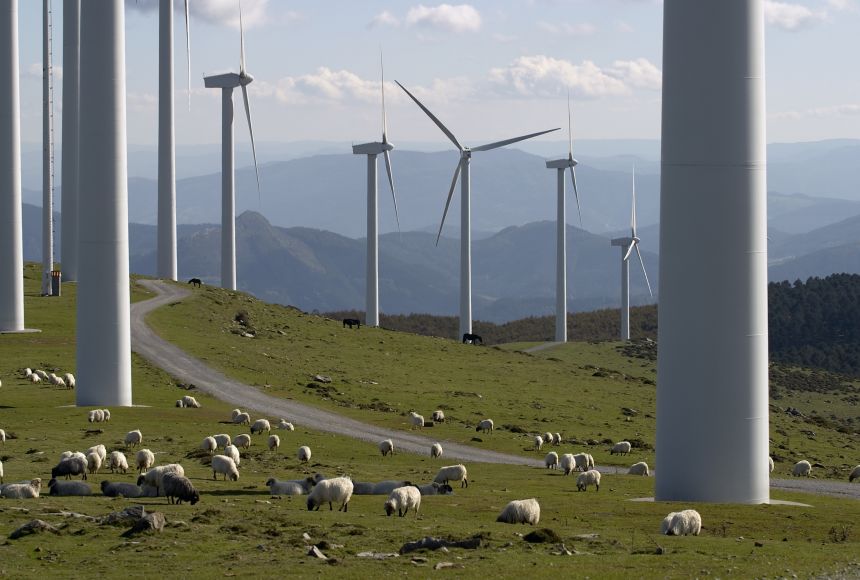Renewable energy is energy that does not get used up. The wind, the sun, and Earth are sources of renewable energy.
Solar Energy
Solar energy comes from the sun. There are two types: active solar energy and passive solar energy.
Active solar energy uses special technology to capture the sun's rays. The two types are photovoltaic cells (PV cells or solar cells) and mirrors. They focus sunlight in a specific spot to generate electricity. PV cells last for a long time and are efficient.
Passive solar energy does not use equipment. This energy comes from natural sunlight. One example is building a house so that it faces the sun more often. More sun means more heat.
Solar power cannot be used as the only power source in a community. It can be expensive to install PV cells or build structures that use passive solar technology.
Also, it is difficult to say when we will get sunshine. The sunlight we get depends on where we live, the season, and the time of the day.
Wind Energy
Throughout history, people have used the wind's energy. Ancient Egyptians made boats powered by the wind more than 5,000 years ago. In 200 B.C.E., people used windmills to grind grain in the Middle East and pump water in China.
Today, we use wind turbines. Turbines are towers with two or three blades at the top. The wind turns the blades. The blades turn a generator inside the tower. The generator creates electricity. Turbines do not release pollutants into the air.
Groups of wind turbines are known as wind farms. Wind farms can be found near farmland, in narrow mountain passes, and even in the ocean.
If winds are steady, we get cheap electricity. But wind speed depends on the location, time of day and weather. So we cannot rely on it fully. Also, wind turbines are dangerous for bats and birds. They can crash into them.
Geothermal Energy
The center of the planet is extremely hot. It's more than 6,000 degrees Celsius (about 10,800 degrees Fahrenheit). Geothermal energy makes use of this heat.
We can access underground geothermal heat in different ways. One way is to use geothermal heat pumps. Hot water from underground is used to heat houses and other buildings. Geothermal heat pumps can be used to heat houses, sidewalks, and even parking lots.
Another way to use geothermal energy is with steam. In some areas of the world, there is underground steam that naturally rises to the surface. The steam can be piped straight to a power plant.
In Iceland, there are large reservoirs of underground water. Almost 90 percent of people in Iceland use geothermal as an energy source. They heat their homes and businesses.
Biomass Energy
Biomass is material that comes from plants or animals. Plants create energy from the sun through a process called photosynthesis. This energy is stored in the plants even after they die.
Trees, branches, bark, and recycled paper are sources of biomass energy. Manure, garbage, and crops, like corn, soy, and sugar cane, can also be used for biomass.
We get energy from biomass by burning it.
Biomass can also be made into biofuel. It can power cars and trucks when mixed with gasoline. Biofuels release less harmful pollutants than gasoline.
Biomass can be stored and used when it is needed. However, to grow crops for biofuels, we need large amounts of land and pesticides.
Hydroelectric Energy
Hydroelectric energy is made by flowing water. Most hydroelectric power plants are located on large dams. Dams control the flow of a river.
Dams block the river and create a human-made lake. A small amount of water is forced out through tunnels in the dam. This water turns huge turbines and generates electricity.
Hydroelectric energy is inexpensive and reliable. Water is constantly flowing and so the dam does not depend on the weather and time of day.
But when a river is dammed, it creates a large lake behind the dam. This lake can drown the original river habitat and sometimes entire towns.
Other Renewable Energy Sources
Scientists and engineers are working to make use of other renewable energy sources. Three promising examples use ocean tides, waves in water, and algae.
Tidal energy uses ocean tides to generate electricity. Moving tides turn the blades of a turbine.
Wave energy uses waves from the ocean, lakes, or rivers. They work in the same way as tidal energy.
Algal fuel is a type of biomass energy that uses the chemicals in seaweed to create a clean and renewable fuel. This kind of fuel does not need the acres of cropland that other biofuel sources do.
